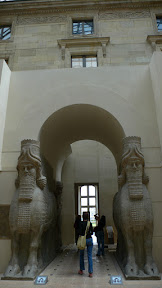

| [full gallery] | ||
| Previous: Building | Up: The Louvre | Next: Classical |
Congratulations! By reading this blog you have demonstrated that you are the most bored person on the planet.


| [full gallery] | ||
| Previous: Building | Up: The Louvre | Next: Classical |

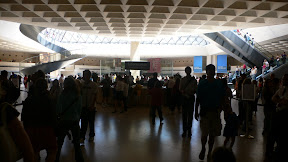
Recently, much of the foundation of the original castle has been excavated, and you can walk around a section of its perimeter. These foundations were laid around 1190, with the more recent (and visible) building starting in 1535.

The Louvre, although not oriented with the axis (like the Grande Archew), is supposedly the starting point for axe historiquew, in particular, the equestrian statue of Louis the 14th. And here he is, Louisw et poupé:
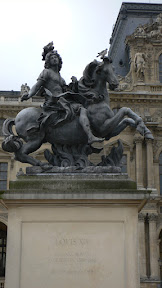
| [full gallery] | ||
| Previous: The Louvre | Up: The Louvre | Next: Antiquities |

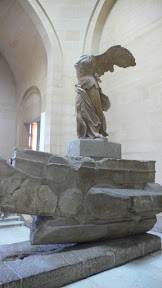
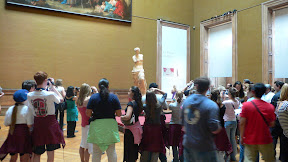
There is also this odd little sculpture,


Many of the works were under restoration when I was there.
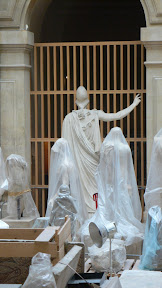
| [full gallery] | ||
| Previous: Antiquities | Up: The Louvre | Next: Medeival |
This is a log of my one month trip to France (mostly) and Belgium in the summer of 2006. I arrived about a week into June and returned to the US at the end of the first week of July, spending virtually all the time in Paris, where I rented an apartment. I took four day-trips outside of Paris (Amiens, Bayeux, Caen, and Chartres), and spent the last three days of the vacation in Brussels.
I'm starting to put this together now (January, 2007), using Blogger and Picasa Web. I divided my trip photographs into a variety of albums (34 in total), and my plan is to write a short web log entry to provide an overview for each album, followed by a link to that album. As per usual with web logs, I'll try to link useful sites into the entries, and embed a few "teaser" images from that location. The most commonly referenced site will be Wikipedia w, and which I will link using a superscripted "w".
My relatives helpfully provided me with travel guides for my birthday:
Of these, Daytrips France was perhaps the most frequently referenced, in part because this was the way I did most of my travelling in France, and also because of the handy "Walking Tours" of Paris itself.I had a major advantage in that I had a friend (Scott Hutchins) staying in Paris at the time (on a Stanford fellowship at the Cité Internationale des Arts). Scott speaks French, lived in France in the past, and had been there 5 or 6 months when I arrived, so he was able to give me a good orientation. Incidentally, I do not speak French, and essentially learned none. At the end of my stay, after greeting a shopkeeper with "Bonjour Monsieur" about 1 in 10 would bother responding in French.
I bought a Panasonic Lumix DMC-LX1 for the trip (courtesy of my parents). I've come to terms with the fact that I'm not a great photographer, and I chafe at lugging to much gear around, so I wanted a compact camera with decent picture quality and some kind of zoom. That the DMC-LX1 defaulted to taking 16:9 aspect ration photographs sealed the deal for me. It seemed like the perfect compact for taking travel-style (lots of landscapes) pictures, and I think that it was. Alas it was stolen on my last day in France, but fortunately I only had about a day and a half of footage from Brussels on it at that point (the Comic Book Museum and Mort Subite mostly). I will say that the problems with the camera related on the Digital Photography Review site are very real, and can be a pain to work around, but that didn't stop me from recently replacing the camera with the next generation model, the DMC-LX2. Of course, you can judge the pictures yourself, but generally the color issues don't appear unless you download the full size (3MB+) image.
I'll be adding to this journal over time -- my initial goal is to get all of the Montmartre albums and log entries published first, and proceed from there. Since the entries will appear in the web log in a semi-random fashion, I'll have a link to this page readily available on the right, and I will also post an entry that will serve as a hyperlink table of contents. I'll have the full tree available at first, and then continually update it with links as the entries and albums are finalized. Please -- use the comments section to point up errors in grammar, spelling, facts and particularly broken links.
I'm just getting a handle on Google's Blogger, so things will change around a lot as time goes on. One of the issues I'm currently having is that even though they claim to have an "Edit Html" mode and a WYSIWYG-style "Compose" mode, entities seem to disappear, while line breaks seem to be maintained. The latter makes it extremely hard to write useful HTML. I apologize in advance for odd spacing throughout the text.
[Update] I'm starting to get the hang of this -- I found the setting to turn off automatic line-breaks, and I'm editing the old files to restructure them now that I can use HTML tags the way I expect to.
Well! On to the Table of Contents.


The cemetery is a proper necropolis, laid out with named streets and alleys running between the graves. Maps dotted around the grounds help direct you to the famous dead, but most of the non-famous tombs are fun to check out.
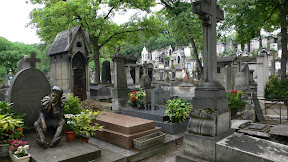
| [full gallery] | ||
| Previous: About | Up: Montmartre | Next: The Louvre |


A few of Montmartre's famous moulins remain (although non-functional), along, of course, with Baz Luhrmann-violated Moulin Rouge w. Old medieval streets (with gutters in the center) are preserved there, along with avant-garde hangouts from the turn of the century, surrealist sculptures. The original Art Nouveau w entrances to the Métrow by the architect Hector Guimard w still stand.
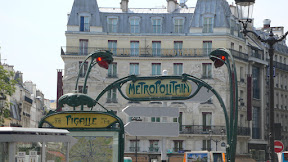
Here, a trifecta -- the Moulin Rouge, with it's adjacent property -- a Quick Burger w franchise (France's answer to McDonald's, both of which are wildly successful), and the cheeseball tourist train that made a regular circuit from Sacré-Coeur, past my window, and on down to Pigalle w:

| [full gallery] | ||
| Previous: Sacré-Coeur | Up: Montmartre | Next: Cemetery |


| [full gallery] | ||
| Previous: Stairs | Up: Montmartre | Next: About |
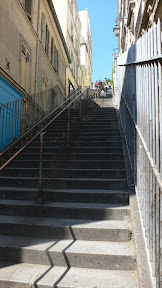
| [full gallery] | ||
| Previous: Home | Up: Montmartre | Next: Sacré-Coeur |
Since I wanted to spend most of my time in Paris, I rented an apartment instead of a hotel room.
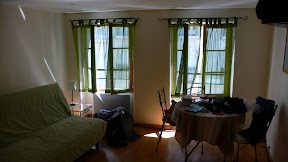
The Montmartre w apartment (#6 Rue Cortot) was tiny, little bigger than a very modest hotel room in fact, but suited my needs. It felt a lot like home, being up on top of a hill, and also that odd mix of tourist-land and old neighborhood.

The first thing I did after signing the lease was walk down the hill to the nearest hardware shop, where I bought the biggest fan I could find. It would turn out to be the smartest thing I did that month. It would take me another three weeks to figure out how to keep milk in the painfully underpowered minifridge from going off within a day.
| [full gallery] | ||
| Previous: Montmartre | Up: Montmartre | Next: Stairs |
 |
| From france.paris.... |
 I'll also try to have enough text to test the wrapping capability, as well as try modifying the default html that you are given when you choose the "embed in blog" option in Picasa. Ideally I'll be able to pepper my posts with images, and thus have short narratives to help tie the albums together.
I'll also try to have enough text to test the wrapping capability, as well as try modifying the default html that you are given when you choose the "embed in blog" option in Picasa. Ideally I'll be able to pepper my posts with images, and thus have short narratives to help tie the albums together.